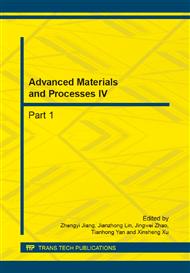p.270
p.277
p.284
p.288
p.292
p.296
p.302
p.306
p.310
Hydrothermal Synthesis, Photoluminescence and Room Temperature Ferromagnetism of Co-Doped Rod-Like ZnO Particles
Abstract:
Co-doped rod-like ZnO particles with nominal Co doping concentration of 1 at% were synthesized by hydrothermal method and characterized by X-ray diffraction, field-emission scanning electron microscopy, photoluminescence and superconducting quantum interference device. The results show that the as-synthesized samples are pure hexagonal wurtzite structure without metallic Co or other secondary phases and display rod-like shape with smooth surface. The room temperature PL spectrum of the Co-doped rod-like ZnO particles exhibits a strong blue emission at 440 nm, a shoulder violet emission at 410 nm and a weak green emission centered at 550 nm. The magnetization measurements reveal that the Co-doped rod-like ZnO particles show ferromagnetic behavior at room temperature. The saturation magnetization and coercive field are 0.0125 emu/g and 45 Oe, respectively.
Info:
Periodical:
Pages:
292-295
Citation:
Online since:
September 2014
Authors:
Keywords:
Price:
Сopyright:
© 2014 Trans Tech Publications Ltd. All Rights Reserved
Share:
Citation:


